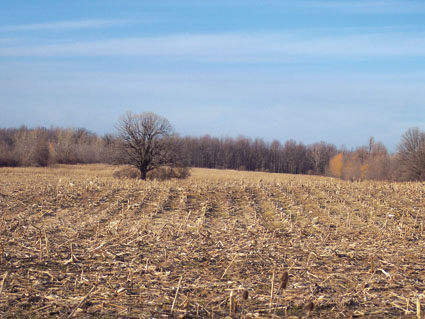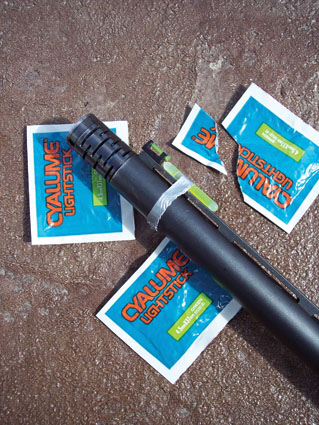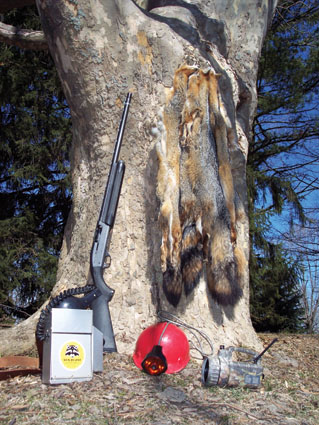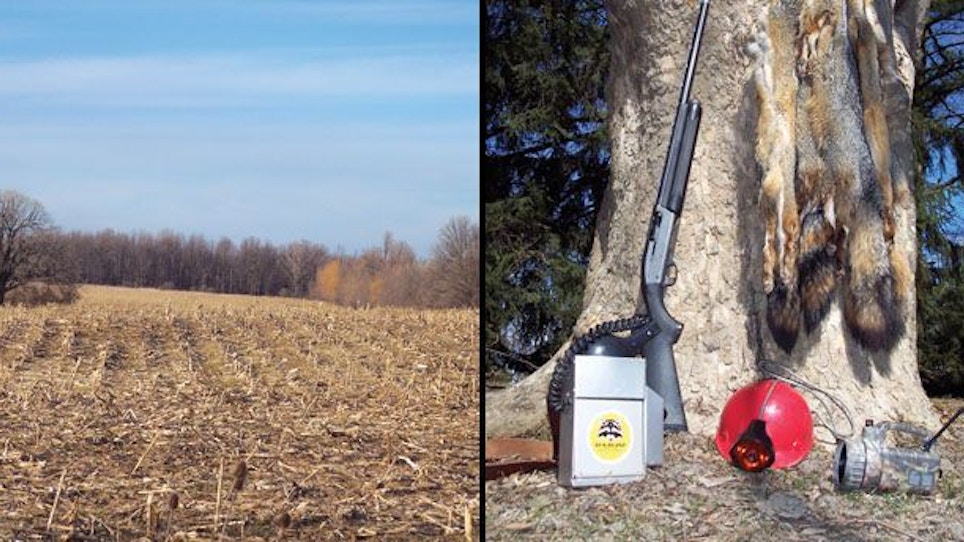 I reached for the arm of my “Call of the Wild” record player and placed it on the revolving 45. A noise resembling frying bacon blared out of the metal speaker, then quickly transformed into the sounds of a grey fox pup in distress. I still wasn’t sure about all of this; I was on my third calling stand of the evening and hadn’t seen anything that resembled a set of eyes.
I reached for the arm of my “Call of the Wild” record player and placed it on the revolving 45. A noise resembling frying bacon blared out of the metal speaker, then quickly transformed into the sounds of a grey fox pup in distress. I still wasn’t sure about all of this; I was on my third calling stand of the evening and hadn’t seen anything that resembled a set of eyes.
The six-dollar headlamp dug into my forehead and the weight of the six-volt battery on my belt loop worked at pulling my wool pants down, making room for the cold November wind to find its way to my bare skin. The red headlight seemed to cast no illumination at all. I was starting to question my sanity. I had saved for months to buy the caller, and read everything I could about predator calling. Still, I knew no one personally who was calling predators here in Upstate New York. “Maybe these methods don’t work here,” I thought.
As I reached to pull up my pants up for the third time, I noticed a red light moving though the hardwoods in my direction. My immediate thought was somebody must be coon hunting and my calling stand was now blown. I started to reach for the on/off switch when I realized the glow was too close to the ground and moving much too swiftly through the underbrush to be another hunter. When the light progressed to the edge of the timber, my heart stopped. It was just like I read about in Russell Tinsley’s book, “The Critters Come When Called,” a pair of eyes that looked like two hot coals were staring out at me.
These had to belong to a fox. The peepers paused for a second, then came bouncing out into the cut cornfield. I raised my 12-gauge as the glow closed in on the distress sound. When the red beacons moved to what I guessed was 30 yards, the outline of a small fox appeared against the snowy background. I clicked off the safety and pulled the trigger in one motion—then everything went dark.
I stared into the blackness in shock. What had just happened? The eyes had disappeared the instant I fired. I couldn’t have missed, could I? My legs trembled as I rose from my squatting position. Standing, I made out something dark in the snow where I last saw the spook. As I stumbled to the object my pulse raced. There, lying in the snow was the first grey fox I had ever seen…let alone harvested.

That was 25 years ago and I’ve been hooked on varmint calling ever since. Back then there were no predator calling videos. The few books available focused on calling out West, which to an eastern predator hunter is as different as moose and mouse scat. Consequently, over 25 years of calling, I had to learn the hard way. This can make an old-school varmint hunter tight-lipped on his well-earned tricks of the trade. However, with predator numbers in the East growing at an alarming rate, there are more than enough critters to go around. The joy of introducing others to the great sport of predator calling overrides any urge to keep my lessons under wraps.
Favorite Song
Things have changed drastically since the days of the bulky record player caller. My old “Call of Wild” record player sits in my closet retired, replaced by a high-tech digital job equipped with 32 sounds and remote control. The unit weighs less than a tenth of what the cumbersome record player did. My 6-volt headlamp has long since been replaced by a 12-volt hardhat headlight/hand spotlight combo. Even with all the fantastic improvements to the sport, there is still one thing that hasn’t changed since that night 25 years ago, the grey’s favorite song.
For eastern grey fox there is still no sound that works as well as the Grey Fox Pup in Distress. For some reason, these cat-like fox throw caution to the wind when coming to this bawl, often disregarding scent and sound to check out the source of the distress. I’ve had hunting partners shoot at a grey, then have it stay in shotgun range for a second and third shot. Shooting multiple grays at one stand is a common occurrence.
The man credited in the East for developing the call was Jim Smith of Summerville, PA. Mr. Smith produced the sound on a 45 record in the late 50’s after dispatching a very vocal grey fox he had trapped. The trapped fox’s distress cries brought another grey on the run. The second fox ran around in a frantic state, agitated by the trapped fox’s yelps. That recording helped Jim start Smith Game Calls that is still in business today.
The only drawback to the Grey Fox in Distress call in the East is you are pretty much limited to calling in grey fox. I call in areas thick with both grays and reds, but never had a red respond to the Grey Pup. Coyotes occasionally show, but usually hang up well out of shotgun range. I do not spare the volume when I call grays to the sound; a louder call seems to drive these critters even crazier. They will, in many cases, charge directly to the front of the blaring speaker.
Think Bunnies
Scouting is key to success on eastern grays. When looking for calling stands, it helps to think bunnies. Where you find rabbit cover, you find grays. It’s not so much that rabbits are a huge part of a grays’ diet. It’s more likely this type of territory is a place where wild grapes and other fruits grow, rodents thrive, and the small fox can feel safe from their main predator, the coyote. Open fields adjacent to this dense cover are premium calling locations.

In late season, calling frozen swamps can be another hotspot. The hard water makes great highways for all predators. All night-calling stands should be scouted during daylight hours. I actually walk to a stand during the day to figure out precisely where I’m going to set up, then put a small piece of reflective tape on a branch or bush so I can find it quickly in the dark. In Upstate New York with a high density of grays, I scout with the assumption there is a grey fox in every significant piece of thick cover. Not that there are, but my confidence level is high that a grey will be somewhere in that neighborhood.
I’m not as concerned about looking for actual fox sign as I am looking for good vantage points to thick cover. Strong wind is an eastern caller’s number one nemesis, followed closely by deep powdered snow. Grays will hole up for days after a good snow. When they do venture out, they will not push deep snow to get to your call unless they are close in the first place. I seldom call in winds over 15 MPH or powdered snow deeper than six inches.
Packed snow is a different matter all together. A good, dark cold night when the snow is packed hard enough to hold a grey’s weight can be your best calling of the year. Just before a storm can also be a great time to hunt. The darker the night, the better. Fox are actually easier to see at night than during the day. On a dark night, I can see a fox’s eyes reflect at well over 100 yards. During daylight, a fox will usually approach using all the cover possible.
Time Is Fur
I subscribe to the “time is fur” theory of grey fox calling. I want to get in as many stands as possible on a given night. When calling grays on a good, dark, windless night, I only stay about 10 minutes in a calling location; if it’s windy, 15 to 20 minutes. Ninety percent of the grays I’ve called in over 25 years have shown up in the first 5 minutes, so I’m in and out. I realize some fur is being passed up, but I like playing percentages. I try to line up at least a dozen spots for an evening’s session. I stay away from stands that take a long time to walk into, though I will not call within sight of my vehicle.
The best hours are just after dark and just before dawn, but there is something to be said for calling after midnight when human activity such as traffic is at a minimum. A good hunting partner is another plus. Besides the obvious benefit of easier surveillance in all directions, a buddy can help cast his light while the other hunter shoots. When doing this, be careful not to shine your light directly on your partner.
Though a lone hunter is less conspicuous, solo night calling is not for the faint of heart. The feeling of being hunted hits harder when you’re calling alone at 2 a.m. in the middle of nowhere on a dark, windy, night. Visions of boogeyman can creep into your brain!
Gun Choice
My preferred gun when night calling for grays is a 12-gauge with a turkey load. Copper No. 4 shot is bad medicine for these small fox out to 40 yards. Rifles are tricky after dark for small targets. Half of what you see on a fox is hair. The vital area, his head, is about 3 inches in diameter. The body’s vitals are about 4 inches high, 3 inches wide and 7 inches long. Judging distance in the dark is challenging and takes experience. In my early calling days I missed as many fox as I harvested due to my inability to judge yardage in the dark.
Keeping your head down on the stock is another problem when the adrenaline rush of a charging set of eyes hits. Ask any turkey hunter and they will tell you what happens if your head comes up to look at what should be an easy target. I use tiny glow sticks that are available in most fishing tackle stores for night fishing. They are about two inches long. I mount one just in front of the front bead of my shotgun with a piece of duct tape. Their glow will last a full night, and it will work wonders for keeping your head on the stock.
Fashion
Don’t worry too much about camo after dark. I wear dark clothes that are quiet. If your clothes rustle even a little when you move, change them. On snow cover, I wear white. It is more important to keep your silhouette from being outlined by sky or artificial light than it is to wear camo in the dark. On a dark night with no snow, I often call right in the open. Many a grey fox have bought it with me set up smack in the middle of an open field.
Totally Easy
Eastern grey fox are the easiest of all four-legged predators to call. Go get a Grey Pup in Distress sound on any of these fantastic calling units on the market. Buy a light with a red lens. Grab your 12-gauge turkey gun and get after it. Remember, when hunting eastern grays—time is fur.






